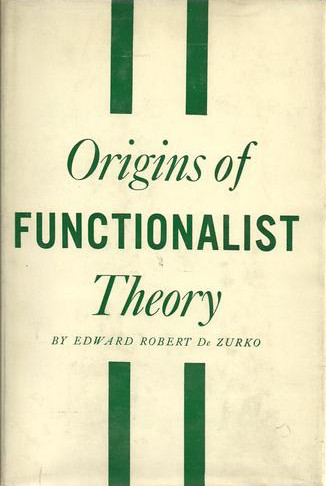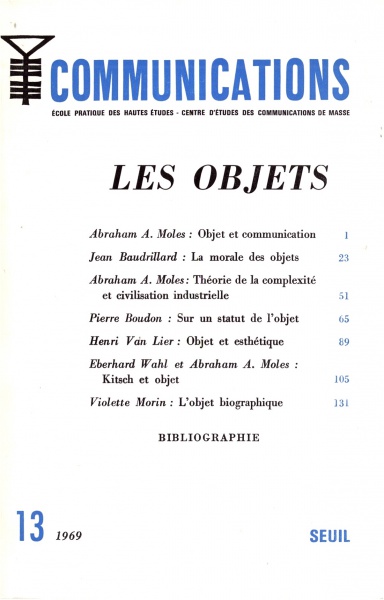Edward Robert de Zurko: Origins of Functionalist Theory (1957)
Filed under book | Tags: · aesthetics, architecture, art, beauty, functionalism, history of architecture, machine, nature, rationalism, theory

“The main purpose of this book is to study the idea of functionalism from a historical point of view. The research media are the literary sources of functionalism. Early functionalist trends in writings on architecture shall be analyzed and compared with each other and with modern interpretations of the concept. By means of this essentially semantic study I hope to demonstrate (1) the antiquity of functionalist ideas, especially the tendency to connect ideas of use with ideas of beauty; (2) the variety of guises assumed by this type of theory; and (3) the recurrent ideas which have generally characterized functionalist theory.” (from the Introduction)
Publisher Columbia University Press, 1957
265 pages
via Charles
PDF (9 MB)
Comment (0)Speculations V: Aesthetics in the 21st Century (2014)
Filed under journal | Tags: · aesthetics, art, avant-garde, literature, philosophy, speculative realism, theory

“Ever since the turn of the century aesthetics has steadily gained momentum as a central field of study across the disciplines. No longer sidelined, aesthetics has grown in confidence. While this recent development brings with it a return to the work of the canonical authors (most notably Baumgarten and Kant), some contemporary scholars reject the traditional focus on epistemology and theorize aesthetics in its ontological connotations. It is according to this shift that speculative realists have proclaimed aesthetics as “first philosophy” and as speculative in nature. With speculative realism aesthetics no longer necessarily implies human agents. This is in alignment with the general speculative realist framework for thinking all kinds of processes, entities, and objects as free from our allpervasive anthropocentrism which states, always, that everything is “for us.”
This special issue of Speculations: A Journal of Speculative Realism explores the ramifications of what could be termed the new speculative aesthetics. In doing so, it stages a three-fold encounter: between aesthetics and speculation, between speculative realism and its (possible) precursors, and between speculative realism and art and literature.”
With contributions by Steven Shaviro, Theodor Leiber and Kirsten Voigt Sellars, Matija Jelača, Claire Colebrook, N. Katherine Hayles, Jon Cogburn and Mark Allan Ohm, Miguel Penas López, Graham Harman, Bettina Funcke, Thomas Gokey, Robert Jackson, Roberto Simanowski, Francis Halsall, Magdalena Wisniowska Disegno, and Sjoerd van Tuinen.
Edited by Ridvan Askin, Paul J Ennis, Andreas Hägler, and Philip Schweighauser
Publisher punctum books, Brooklyn, NY, May 2014
Creative Commons License BY-NC-SA
ISBN 0692203168, 9780692203163
ISSN 2327-803X
474 pages
PDF (single PDF, 9 MB, updated on 2016-12-24)
PDFs (individual essays, updated on 2016-12-24)
Moles, Baudrillard, Boudon, van Lier, Wahl, Morin: Les objets (1969/71) [French, Spanish]
Filed under book | Tags: · 1968, aesthetics, design, object, philosophy, political economy, psychology, semiotics, sociology, theory

Communications is a biannual social sciences journal founded by Georges Friedmann, Roland Barthes, and Edgar Morin. Soon after its start in 1961 it became a reference publication for media studies and semiotics in France and internationally.
Its first 1969 issue was dedicated to the theory of objects, positioning it “at the confluence of sociology, political economy, social psychology, marketing, philosophy, design and aesthetics” (p 141). At the same time the journal argued for the relevance of the study of objects for governmental institutions such as “the Ministry of Industrial Production, the Ministry of Transport, the customs authorities, the courts, the counterfeits studies, or the National Industrial Property Institute” (p 141).
It can be read as a post-May 1968 attempt to use the concept of object as an agent linking social sciences in order to increase their impact on direct political change, and as well as an early echo of what more than a decade later came to be known as the actor-network theory.
Two years later the magazine appeared in its Spanish translation in book form.
Communications 13
Publisher Centre d’études des communications de masse, École pratique des hautes études, and Seuil, Paris, 1969
139 pages
Les objets (French, 1969), View online
Los objetos (Spanish, trans. Silvia Delpy, 1971/1974)

